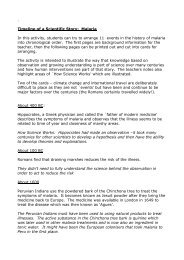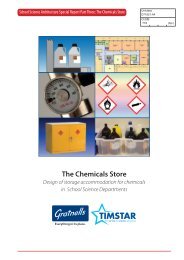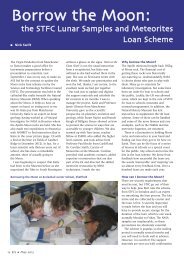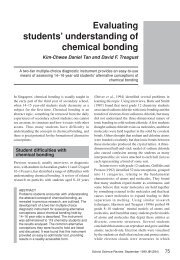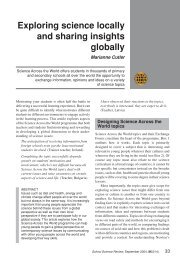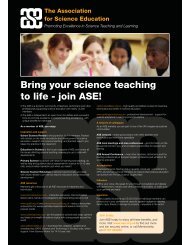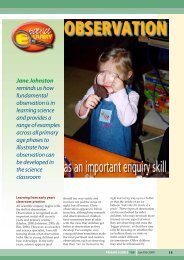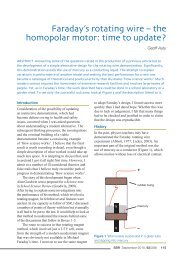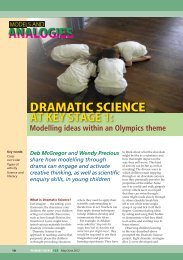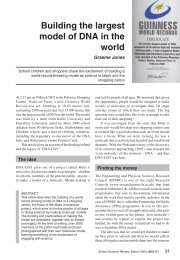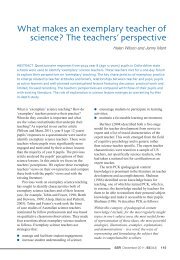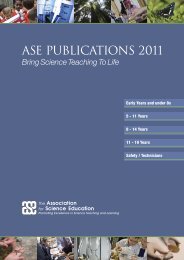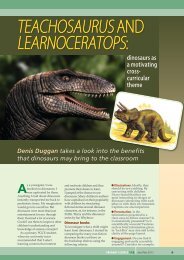Index to Volume 84 - The Association for Science Education
Index to Volume 84 - The Association for Science Education
Index to Volume 84 - The Association for Science Education
You also want an ePaper? Increase the reach of your titles
YUMPU automatically turns print PDFs into web optimized ePapers that Google loves.
■<br />
<strong>Index</strong><br />
<strong>Index</strong> <strong>to</strong><strong>Volume</strong> <strong>84</strong><br />
This index is in three parts: Title,<br />
Subject and Author.<br />
Title index<br />
3-Danaglyph imagesof molecular<br />
models (308) 34<br />
A21st century sciencelabora<strong>to</strong>ry (309)<br />
87<br />
Abest-fitline using the method of<br />
averages(306)122<br />
Acoreconceptin teaching chemistry<br />
(306) 105<br />
Acut-out 3-Dmodel of DNA (308) 30<br />
Atime-line <strong>for</strong>geologicaltime (306)<br />
125<br />
Atribute<strong>to</strong>DickWest (307)126<br />
Anillustration of cladding on optical<br />
fibres (309) 24<br />
Anhydrous aluminium chloride and<br />
aluminiumhydride (307)117<br />
Anotherlook atthe condensation bands<br />
produced by hydrogen’s squeaky<br />
pop (309) 13<br />
Bringing newspaper reports in<strong>to</strong> the<br />
classroom: citizenship and science<br />
education (309) 121<br />
Building a3-DLego model of DNA<br />
(308) 26<br />
Can the quest <strong>for</strong> best practice be<br />
assisted by <strong>for</strong>mal research? (307)<br />
61<br />
Changing practice –teachers have <strong>to</strong><br />
do it <strong>for</strong> themselves (308) 14<br />
Charge is not even skin deep (307) 123<br />
Children’s perceptions of school<br />
science(308) 109<br />
Confidenceintervals,the meanand<br />
Excel (309) 29<br />
Coverage in GCSE textbooks (308) 16<br />
Delivering effective training <strong>for</strong> the<br />
Key Stage 3National Strategy <strong>for</strong><br />
science(306)49<br />
Designing anorganism(309) 11<br />
Discovering DNA (308) 36<br />
DNA <strong>for</strong>real:learning about PCR in<br />
sciencecentreworkshops(308) 49<br />
DNA in the school curriculum–a<br />
poorly exploited asset? (308) 57<br />
DoesICT in sciencereallyworkinthe<br />
classroom? Part 1:<strong>The</strong> individual<br />
teacherexperience(309) 105<br />
Does science education research count?<br />
(307) 13<br />
Down’s syndrome: anupdate and ideas<br />
<strong>for</strong> student research and debate (307)<br />
115<br />
Ecology fieldworkin16<strong>to</strong>19biology<br />
(307) 79<br />
Effective use ofthe Internet in science<br />
teaching (309) 77<br />
Effective use ofICT in secondary<br />
science: guidelines and case studies<br />
(309) 53<br />
Embedding the Key Stage 3National<br />
Strategy <strong>for</strong> science in<strong>to</strong> departmental<br />
practice (306) 59<br />
Enhancing teaching and learning of<br />
sciencethrough useofICT: methods<br />
and materials (309) 41<br />
Evaporation and boiling –trainee<br />
scienceteachers’understanding<br />
(309) 131<br />
Examining the mismatch between pupil<br />
and teacher knowledge in acid–base<br />
chemistry (308) 81<br />
First steps in educational research: the<br />
experience ofstudent teachers (307)<br />
49<br />
Franklin and Wilkins –the <strong>for</strong>gotten<br />
pair?(308) 75<br />
Freeze-thawweathering demonstrated<br />
in asingle lesson (306)121<br />
HasICT in scienceteaching come of<br />
age? (edi<strong>to</strong>rial) (309) 39<br />
Ideasand evidenceinscience:the<br />
portrayal ofscientists in GCSE<br />
textbooks (307) 89<br />
Improving attitudes <strong>to</strong>science and<br />
citizenship through developing<br />
emotional literacy (307) 103<br />
Investigating the effect of acid on<br />
carbonates using amicroscale<br />
technique (309) 12<br />
In-vitro fertilisation with adifference:a<br />
game of inheritance (308) 39<br />
Linus Pauling and DNA (308) 22<br />
Managing data effectively <strong>to</strong>raise<br />
attainmentin keystage 3science<br />
(306) 27<br />
Managing people –the art of science<br />
teacher development (306) 17<br />
Managing health and safety in science<br />
departments (306) 33<br />
Managing science insecondary schools<br />
in Ireland (306) 39<br />
Managing the curriculum (306) 23<br />
Method of least squares –isit really<br />
necessary?(309) 9<br />
Modelling DNA in the lab (308) 24<br />
Moni<strong>to</strong>ring progress within key stage 3<br />
(307) 12<br />
Observing the antimicrobial effects of<br />
plastic impregnated with triclosan<br />
(306)119<br />
One school’s experience ofthe key<br />
stage 3National Pilot (306) 53<br />
Playing withparticles–ateaching<br />
approach <strong>for</strong>A-level (post-16)<br />
particle physics(307)118<br />
Powerpoint :just another slide show or<br />
ausefullearning aid? (309) 61<br />
Primary <strong>Science</strong> Review 2001–2: some<br />
themesof interest <strong>to</strong>secondary<br />
teachers (306)111<br />
Put the champagne on ice(306)14<br />
Rationale and methodologyof testing<br />
and assessment (308) 12<br />
Re<strong>for</strong>ming school science education in<br />
the light of pupil views and the<br />
boundaries of science (307) 71<br />
Responding <strong>to</strong>alternativeconceptions<br />
in the classroom (308) 99<br />
RNA versus DNA (308) 19<br />
<strong>Science</strong> and disease: where life and<br />
death intersect (309) 31<br />
<strong>Science</strong> education research and practice<br />
–doesitcount?(308) 12<br />
<strong>Science</strong>orscienceeducation research<br />
(308) 9<br />
<strong>Science</strong> teachers as researchers –a<br />
model <strong>for</strong> professional development<br />
(307) 43<br />
<strong>Science</strong> teaching and literacy,part 3:<br />
Speaking and listening,spelling and<br />
vocabulary (306)83<br />
Some modelling ideas <strong>for</strong> teaching<br />
about DNA (308) 24<br />
Strategies <strong>for</strong> making effective use of<br />
ICT in sciencelessons(309) 93<br />
Students’understanding of acid,base<br />
and saltreactionsin qualitative<br />
analysis (308) 89<br />
Tackling key stage 2<strong>to</strong>3transition<br />
problems–abridging project(306)<br />
99<br />
Talk,action and visual communication<br />
in the teaching and learning science<br />
(308) 117<br />
Technology in scienceteacher<br />
education (309) 99<br />
School <strong>Science</strong> Review ,June 2003, <strong>84</strong>(309) 157
<strong>Index</strong><br />
■<br />
<strong>The</strong> ChemSketch windfall (309) 19<br />
<strong>The</strong> discovery of the double-helix: a<br />
brief his<strong>to</strong>ry of the MRC Labora<strong>to</strong>ry<br />
of Molecular Biology (308) 65<br />
<strong>The</strong> DollyMixturemodel of the DNA<br />
double helix (308) 23<br />
<strong>The</strong> keystage 3NationalPilot<strong>for</strong><br />
science –areview (306) 43<br />
<strong>The</strong> method of averages versus the<br />
method of least squares (308) 14<br />
<strong>The</strong> nature ofscience education<br />
research(307)35<br />
<strong>The</strong> role of the head ofscience in<br />
managing the KeyStage 3National<br />
Strategy <strong>for</strong> science (306) 63<br />
Thinking frameworks<strong>for</strong>planning ICT<br />
in sciencelessons(309) 113<br />
Towards evidence-based practice in<br />
scienceeducation (307)19<br />
Using data effectively <strong>to</strong>raise<br />
attainmentin keystage 3science<br />
(306) 33<br />
Using Powerpoint effectively in<br />
scienceeducation:lessonsfrom<br />
researchand guidance<strong>for</strong>the<br />
classroom (309) 69<br />
Using the internet<strong>for</strong>dazzling DNA<br />
teaching (308) 45<br />
Why is emotional literacy important <strong>to</strong><br />
scienceteachers?(306)97<br />
Why professional development should<br />
challenge teachers’corebeliefs<br />
(306) 77<br />
Year 6<strong>to</strong>Year 8tracking: investigating<br />
the keystage 3dip (307)65<br />
Subject index<br />
acid-base chemistry, mismatch with<br />
pupils’understandings(308) 81<br />
alternativeconceptions,chemistry<br />
(308) 99<br />
aluminium,compounds(307)117<br />
antimicrobialaction (306)119<br />
attitudes <strong>to</strong>science, pupils (307) 103<br />
best-fit line (306) 122; (309) 9<br />
chemicalequations(308) 89<br />
ChemSketch (309) 19<br />
citizenship, and science education<br />
(307) 103<br />
conceptmapping and professional<br />
development (306) 77<br />
concepts in physics, communicating<br />
(308) 117<br />
condensation bands,hydrogen (309) 13<br />
confidenceintervals(309) 29<br />
corecharge (306)105<br />
CPD and conceptmapping (306)77<br />
Crick, Francis (308) 65<br />
curriculumdevelopment,pupils’needs<br />
(307) 71<br />
curriculum, developing schemes of<br />
work(306)23<br />
Darwin, Charles (307) 89<br />
demonstrations,magnetism(308) 117<br />
DfES Best Practice Research Scholarship<br />
(307)61,65<br />
diseases, and science education (309)<br />
31<br />
DNA 50, specialissue (308)<br />
DNA, in school curriculum (308) 57<br />
and RNA (308) 19<br />
at MRC Labora<strong>to</strong>ry of Molecular<br />
Biology,University of Cambridge<br />
(308) 65<br />
classroom resources(308) 23,24,<br />
30,34<br />
extraction of DNA (308) 36<br />
molecular model (308) 23,30<br />
molecular structure (308) 34<br />
papersculpture(308) 30<br />
Pauling’s contribution (308) 22<br />
using the Internet(308) 45<br />
double helix,brief his<strong>to</strong>ry (308) 6575<br />
Down’ssyndrome, genetics(307)115<br />
earth science, weathering (306) 121<br />
ecology,exercise(309) 11<br />
ecology,fieldwork, post-16 (307) 79<br />
electric fields (307) 123<br />
electrostatic charge (307) 123<br />
emotional literacy (306) 97; (307) 103<br />
Escherichiacoli (306)119<br />
evidence-based practice (307) 19<br />
Excel,confidenceintervals(309) 29<br />
Faraday cage (307) 123<br />
Franklin,Rosalind, (308) 75<br />
game,genetics(308) 39<br />
game,particle physics(307)118<br />
geologicaltime (306)125<br />
health and safety (306) 33<br />
his<strong>to</strong>ry of science, and textbooks<br />
(307) 89; (308) 16<br />
ICT, labora<strong>to</strong>ry design (309) 87<br />
ICT, Powerpoint (309) 61, 69<br />
ICT, technology(309) 99<br />
ICT in scienceeducation, specialissue<br />
(309)<br />
ideas and evidence (307) 89<br />
initialteachertraining,scienceteaching<br />
(307) 49<br />
Internet, DNA, teaching (308) 45<br />
Internet, and science teaching (309) 77<br />
ISED project(307)103<br />
keystage 2science (308) 109<br />
key stage 2<strong>to</strong>3(307) 65<br />
key stage 2<strong>to</strong>3, bridging (306) 69<br />
key stage 3dip (307) 65<br />
key stage 3management, head of<br />
science(306)63<br />
key stage 3National Pilot (306) 43, 53<br />
Key Stage 3National Strategy (306)<br />
49, 59,63<br />
key stage 3, using data effectively<br />
(306) 27; (307) 12<br />
King’s College London, and the<br />
structureofDNA (308) 75<br />
Labora<strong>to</strong>ry of Molecular Biology (308)<br />
65<br />
Lego model of DNA (308) 26<br />
literacy,and science teaching (306) 83<br />
magneticfield patterns(308) 117<br />
Managementand KeyStage 3, special<br />
issue (306)<br />
managing people (306) 17<br />
managing science curriculum, in the<br />
Republic of Ireland (306) 39<br />
method of averages(306)122; (308)<br />
15; (309) 9<br />
method of least squares (306)122;<br />
(308) 15; (309) 9<br />
misconceptions,and QA (308) 89<br />
misconceptions, classroom resources<br />
about (308) 99<br />
National Pilot, key stage 3(306) 43, 53<br />
National Strategy, see Key Stage 3<br />
NationalStrategy<br />
newspaper reports, and science<br />
teaching (309) 121<br />
opticalfibres(309) 24<br />
organism,designing an(309) 11<br />
particle physicsgame (307)118<br />
Pauling, Linus (308) 22<br />
per<strong>for</strong>mancedata(306)27<br />
Powerpoint (309) 61, 69<br />
Primary <strong>Science</strong> Review ,review of<br />
(306)111<br />
professional development (307) 43<br />
professional development, Best<br />
Practice Research Scholarships<br />
(307) 61, 65<br />
pupils’perceptions,KS2science(308)<br />
109<br />
qualitativeanalysis(308) 89<br />
researchers, science education (307) 13<br />
RNA, versus DNA (308) 19<br />
schemes of work, developing (306) 23<br />
sciencecentreDNA workshops(308)<br />
49<br />
science education research and<br />
dissemination (307)13<br />
158 School <strong>Science</strong> Review ,June 2003, <strong>84</strong>(309)
■<br />
<strong>Index</strong><br />
scienceeducation researchand<br />
practice, special issue (307)<br />
science education research, partnerships<br />
(307) 43<br />
science teaching, and emotional<br />
literacy(306)97; (307)103<br />
scientific literacy and citizenship (309)<br />
121<br />
statistics (306) 122; (308) 15; (309) 9<br />
29<br />
teacher development (306) 17<br />
teachers’views of scienceeducation<br />
research(307)35<br />
teaching chemistry concepts (306)105<br />
teaching, educational research, impact<br />
on teaching (307) 19; (308) 9, 12, 14<br />
textbooks,ideasand evidence(307)89;<br />
(308) 16<br />
time-line (306) 125<br />
training, Key Stage 3National Strategy<br />
(306) 49<br />
triclosan(306)119<br />
Wallace,Alfred Russel (307)89<br />
Watson, James (308) 65<br />
weathering, demonstrating (306) 121<br />
West, Dick, atribute <strong>to</strong> (307) 126<br />
Wilkins,Maurice (308) 75<br />
Author index<br />
Aplin, DG(308) 16<br />
Asoko,H(306)111<br />
Auty,G(309) 24<br />
Bartholomew,H(307) 19, 35<br />
Beggs, J(308) 109<br />
Bennett,J(307)7,49<br />
Bentley,D(307) 127<br />
Borrows,P(306)33<br />
Breithaupt,J(308) 16<br />
Brown,D(307)118;(309) 87<br />
Broxham,M(306)53<br />
Campbell,B(307)49<br />
Chaplin,M(309) 93<br />
Chapman,BR(308) 12<br />
Chia, L-S (308) 89<br />
Churchill,H(306)63<br />
Clarke,J(306)59<br />
Collins, S(307) 19<br />
Cromp<strong>to</strong>n,Z(306)49<br />
Dillon, J(306) 7, 17; (307) 43<br />
Doneghan C(307) 103<br />
Duschl, R(307) 19, 43<br />
Edwards, R(306) 23<br />
Erduran, S(308) 75, 81<br />
Essex, J(307) 61<br />
Evans, M(306) 43<br />
Evans, SW(308) 23<br />
Finch, JJ(308) 65<br />
Finlayson,H(309) 105<br />
Forrest,B(309) 11<br />
Gibson,MT(307)65<br />
Glaister,P(308) 14<br />
Goh,N-K(308) 89<br />
Goodwin,A(309) 131<br />
Hames,V(307) 19, 35<br />
Harper,E.(309) 87<br />
Harrison,S(307)103<br />
Henderson,P(309) 12<br />
Heselden, R(306) 83, 121<br />
Hind,A(307)19,35<br />
Hollamby,P(309) 61<br />
Hoppé,J(306)122; (308) 9;(309) 9,<br />
29<br />
Hulse,N(308) 39<br />
Hut<strong>to</strong>n,TAM,(306)119<br />
Jarman,R(309) 121<br />
Jewitt,C(308) 117<br />
Jolliffe,A(308) 49<br />
Jones, R(309) 13<br />
Kilbey,T(307)103<br />
Kinchin,IM(306)77,119<br />
Kumar, DD(309) 99<br />
Leach, J(307) 19, 35<br />
Lewis, J(307) 19<br />
Lewis, S(309) <strong>84</strong><br />
Lock, R(307) 13, 79<br />
Madden,D(306)14;(308) 30,34,36<br />
Matthews,B(306)97; (307) 103<br />
Mazurek,HA(308) 45<br />
McClune, B(309) 121<br />
Millar,R(307) 19, 35<br />
Monk, M(308) 14<br />
Mum<strong>for</strong>d, C(309) 19<br />
Murphy,C(308) 109<br />
Murphy,E(306) 125<br />
Murphy,PJ(306)125<br />
New<strong>to</strong>n,L(309) 113<br />
Nott,M(307)127; (308) 75<br />
Oldham,V(306) 27; (309) 53<br />
Osborne, J(307) 19, 35; (308) 75<br />
Palmer, M(306) 39<br />
Parkinson, J(309) 61<br />
Parrott, MJ(307) 12<br />
Pickersgill,D(309) 77<br />
Ramsden,EN(308) 16<br />
Ratcliffe, M(307) 19, 35<br />
Reiss, MJ(307) 71<br />
Rogers.L(309) 105,113<br />
Rowcliffe S(309) 69<br />
Ryan,M(306)69<br />
Samuels,G(309) 31<br />
Schollar,J(308) 26,30<br />
Scott,P(307)19;(308) 117<br />
Severs,P(309) 12<br />
Seymour, J.(308) 39<br />
Sindall,M(308) 24<br />
Sissling,S(307)43<br />
Souter,N(308) 57<br />
Spoors,M(308) 15<br />
Spurgin, B(307) 123<br />
Staples,R(306)83<br />
Taber, KS(306) 105; (308) 99<br />
Talbot,C(307)115,117; (308) 19,22<br />
Tan, K-C D(308) 89<br />
Tilling,S(307) 79<br />
Treagust,DF(308) 89<br />
Watson,R(307)43<br />
Welling<strong>to</strong>n, J(309) 39<br />
Williams,JD(307) 89<br />
<strong>Index</strong> <strong>to</strong>advertisers<br />
ASE 2, 10<br />
Bio-Rad Labora<strong>to</strong>ries outside back<br />
cover<br />
Biozone Learning Media (UK) 1<br />
BNFL <strong>Education</strong> 38<br />
British Physics Olympiad 92<br />
Brownall Labtaps 98<br />
Cambridge University Press inside<br />
front cover<br />
Long TermTeachers 52<br />
Mil<strong>to</strong>n Lab Furniture 60<br />
PicoTechnology inside back cover<br />
Safelab Systems 40<br />
Spiring Enterprises 52<br />
SSR 313 special announcement 76<br />
School <strong>Science</strong> Review ,June 2003, <strong>84</strong>(309) 159



